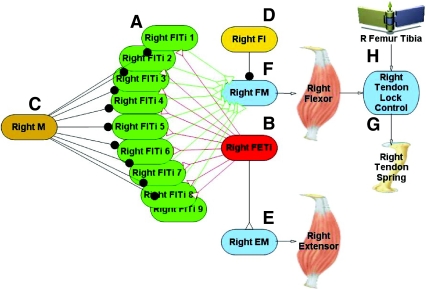Fig. 2.
Neural network model to produce the kick and jump motor programs. Network shown is for the right leg. (A) Nine fast flexor tibia motor neurons (green FlTi). FlTis synapse onto the flexor muscle membrane (light blue FM). (B) A single fast extensor tibia motor neuron (red FETi). FETi synapses onto the extensor muscle membrane (light blue EM). (C) The multimodal interneuron (gold M) inhibits the FlTis. (D) The flexor inhibitor (yellow FI) inhibits the flexor muscle. (E) Depolarization of the extensor muscle membrane causes the extensor muscle to contract. (F) Depolarization of the flexor muscle membrane causes the flexor muscle to contract. (G) The tendon lock control node (light blue) controls when the tendon lock spring is enabled based on the rotation of the tibia and the tension in the flexor muscle. (H) When the jump is triggered the femur–tibia joint rotates rapidly to produce the kick or jump.

